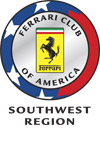
A Hot Lap at Laguna Seca
With the Monterey Historics and a two-day FCA member track event coming up at Laguna Seca later this month, I thought it would be useful to provide an orientation (or memory refresh) of the layout at the track. Below is a word-by-word run through of a lap at Laguna Seca, taken from a July 1989 article in Inside Track, written by T.J. Dersch.Coming past the start/finish finish line and heading down into Turn Two you'll want to line the car up about 12 feet from the right side of the track, straddle the seam so as to have even grip in this heavy braking zone. Turn in, miss the first apex by about 12 feet, carrying a nice decreasing radius line all the way through the corner, allowing you to power-on before the apex. Squeeze on the gas and unwind the wheel.
Coming out of Two, heading in for Three, you get lined up early for this corner. The line through Three is a turn-early line. If you turn in at what you think would be the proper turning point, the track falls off camber. In this corner you always get the sensation that you turn early. If you turn at what you think is the proper point, you miss the apex and run out of road at the exit. So then, turn in a little bit initially to get off the edge of the track, then turn in more once you get into the corner. If you just turn in early, you're going to be pinching the apex and you won't be able to unwind the wheel all the way.
Turn Four is pretty straight forward geometrically. There's no trick to it. It's a fast corner. Lift off, set the car really early for this corner, and get back on the power early.
Turn Five is unique in that the banking reaches its maximum after the apex of the corner. Almost all corners increase banking to the apex, and reduce banking out to the exit. Since the corner blends the new track with the old track, you get an increased banking all the way through the corner. Past the apex, it's still increasing and as you exit the corner you're still on banking. So, you come into this corner, turn in what would maybe be a little early, because the banking somewhat catches you as you go through the corner. This corner always gives you the sensation that you're coming out of it slow, because it's slightly uphill.
The number one priority for Turn Six is to get the car set up early. Get your gear change early, and get your braking done early. Next to Three, Six is one of the more dangerous corners at Laguna Seca. Six is so dangerous in that at lower speeds it's pretty easy to drive. As you pick up in speed the car will get light as it falls into the dip before the apex. This will unsettle the car. The quicker you go, the car starts to drift as you come over the rise, then you come to the dip where it grabs and this will upset the car a bit.
Too many drivers dart to the left going up the hill. You don't want to dart to the left. Stay in the middle of the track and then work your way to the right as you come up and crest over the first hill. The key to the Corkscrew is lining up for Turn Seven. If you don't come over Seven right, you're going to be braking while you're turning and you're not going to get the car slowed down to the right speed. Line up on the left for the turn-in point. Treat it like a decreasing radius corner. You're almost unwinding the wheel as you pass the apex, which is essentially the beginning of the braking zone for Turn Eight. The goal is to get the car straight as you come over the hill.
For the first part of Turn Eight you'll want to sacrifice a little bit of speed. Get back on the power later to induce trail-throttle oversteer. This will point the car correctly for Eight A. You should be able to get on the power hard, you'll launch over the hill, but you'll be in a straight line. Most of the spins that occur in the Corkscrew are due to the car being unbalanced as it crests the hill. This should allow you to hook up well in Eight A. Don't use all the track. You can save 4 or 5
